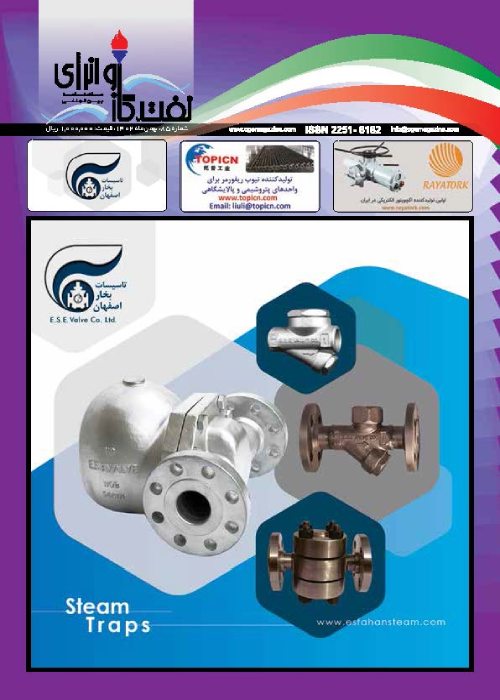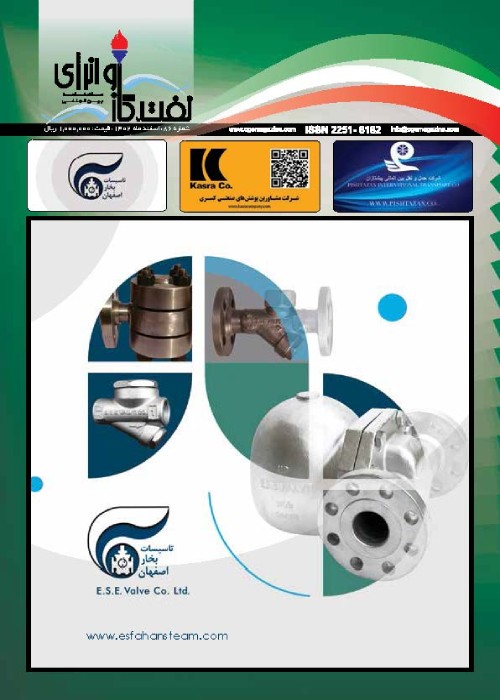فهرست مطالب

ماهنامه نفت، گاز و انرژی
شماره 85 (بهمن 1402)
- تاریخ انتشار: 1402/11/10
- تعداد عناوین: 8
- خبر
-
Pages 2-10
Electro-oxidation is a type of advanced oxidation process, which is based on the use of electrochemical principles to protect the environment. Similar to traditional oxidation processes, oxidizing agents in electrochemical oxidation usually include hydroxyl and sulfate radicals, hydrogen peroxide, chlorine, and ozone. But traditional was tewater treatment methods, compared to the electrochemical process, do not have enough ability to remove toxic and dangerous pollutants. The overall performance of the electrochemical reaction, as well as the rate of production of side products, is highly dependent on the properties of the electrode used. The type of electrodes plays a very important role in the selectivity and efficiency of electrochemical processes. Based on their gender, anodes cause partial and selective oxidation. The use of semiconductor electrodes for the decomposition of organic pollutants in was tewater is also discussed. Among the types of anode electrodes that are mos t used in the electrooxidation process; We can mention PbO2, WO3, SnO2/Sb, RuO2/IrO2/TiO2 and BDD. The electrodes used in the electrooxidation process are made in different ways, including thermal decomposition, laser heating, and electrical deposition, according to the material and function. Also, their performance depends on operating conditions such as concentration, voltage, anode area and cathode material.
Keywords: Electrooxidation, indus trial was te, electrode, BDD, PbO2, RuO2, IrO2, TiO2 -
Pages 11-17
The formation of sediments in the oil indus try is one of the mos t important problems in its various production sectors. These sediments lead to pipe plugging, increase in pipe thickness, channeling of oil flow, reduction in effective area of the pipe and consequently increase in pressure drop. Injection of miscible gas into the oil tank is one of the fas tes t growing enhanced oil recovery (EOR) methods in the world. Measuring the minimum miscibility of MMP is one of the mos t important s teps in planning a miscible gas injection project, for which several experimental and modeling methods have been proposed. One of the mos t important tools for unders tanding the phenomenon of asphaltene deposition is thermodynamic models and experimental relationships for predicting asphaltene deposition. Asphaltene deposition changes the composition of the oil components when it is next to the gas injection, which in turn causes a change in the minimum mixing pressure. Since mos t hydrocarbon mixtures contain nonpolar components, simple EoS can predict the phase behavior of a hydrocarbon mixture. However, for more complex sys tems, a more accurate EoS mus t be used. Also, MMP values decrease with increasing molecular weight in the injection gas
Keywords: miscibility gas injection, MMP, Modeling of asphaltene sediment, EoS -
An Inves tigation of Nanoparticles Properties on Oil Based Drilling Fluid Characteris tics: A ReviewPages 1-10
The depletion of many oil and gas reservoirs and the increase in demand for energy caused us to pay more attention to unconventional reservoirs. Up to now, many researchers used different Nanoparticles (NPs) for improving drilling fluid characteris tics and overcoming drilling operation problems. In this research, the effect of NPs on different parameters of drilling fluid is inves tigated including rheological behavior, filtration volume, lubricity and thickness of mud cake, wellbore s tability, thermal effect, and s tability of emulsion muds. Various effecting factors of drilling fluid such as PH, temperature, and Different properties such as concentration, type, size, and shape of NPs affect nanoparticles efficiency. In this paper, the effect of these factors on the characteris tics of oil-based muds has been inves tigated. According to the literature, it can be concluded that in comparison to usual additives that are used in the drilling indus try, nanoparticles are effective for not only improving drilling fluid characteris tics but also overcoming drilling operation problems
Keywords: Drilling fluid, unconventional condition, Nanoparticles


